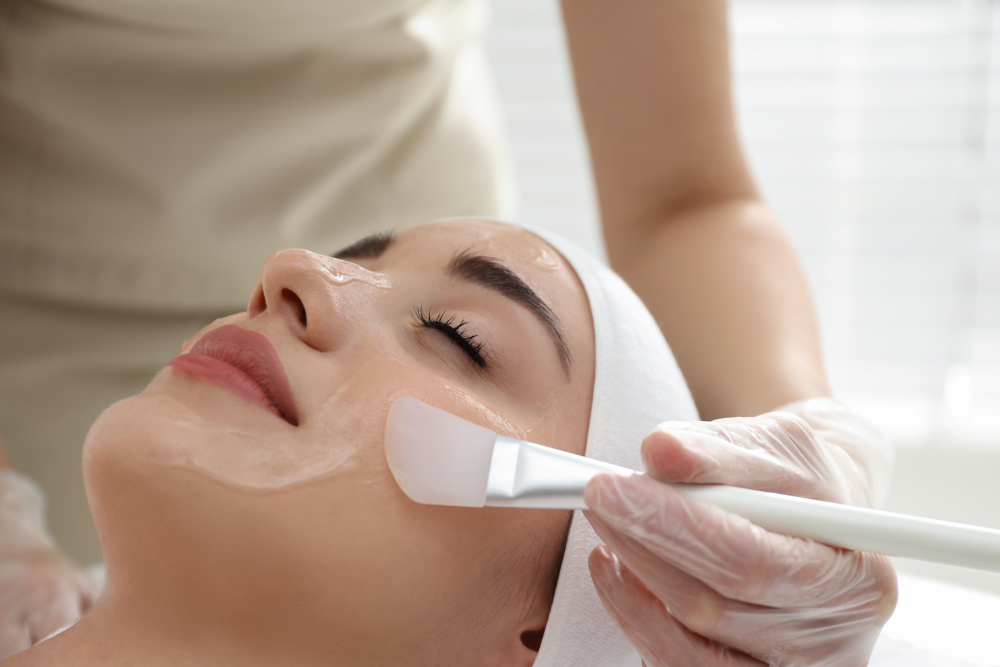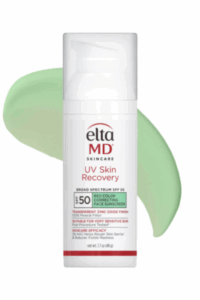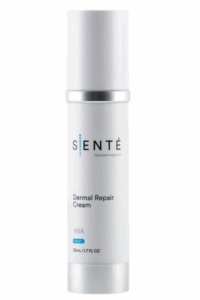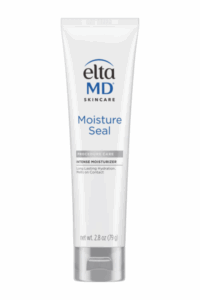Chemical peels are an excellent way to improve the tone and texture of skin. However, they are not often recommended during the summer months due to risk for sun sensitivity. This leaves many people wondering when to get a chemical peel and debating whether it’s worth the risk during the sunny summer months. According to Dr. Alexandra Theriault of U.S. Dermatology Partners Denver, “Chemical peels are a go-to treatment to boost skin health and appearance, but many people skip these types of resurfacing procedures during the summer months because it makes skin more sensitive to sun damage. While this may be a good rule of thumb, it can be perfectly safe to get a chemical peel during the summer, but you might need to take a few more precautions.” In this blog, Dr. Theriault discusses what chemical peels are, how they work, and what extra post-treatment steps you can take to ensure chemical peels are safe and effective during the summer.
What Is a Chemical Peel and How Does It Work?
So, exactly what is a chemical peel? This treatment is performed by dermatologists using a precisely formulated chemical solution that dissolves away the outer layers of damaged skin cells to reveal healthy new skin. Chemical peels are recommended for those experiencing acne breakouts, enlarged pores, uneven skin tone or texture, and hyperpigmentation, and they also improve the appearance of sun damage, fine lines, and wrinkles.
There is more than one type of chemical peel, and treatments can be personalized to meet individual needs, including adjusting the strength of the ingredients during the summer. Dr. Theriault says, “Chemical peels are usually described as being superficial, medium, or deep. This refers to the depth of skin that will be impacted by chemical peels. I don’t usually recommend more than medium-depth chemical peels for the summer since that reduces the severity of side effects and minimizes downtime. The main thing I emphasize with any dermatology procedure is work with your dermatologist to develop a personalized plan and follow up right away if you notice any concerns.”
Benefits of Getting a Chemical Peel in the Summer
If you’re considering a summer chemical peel, Dr. Theriault says, “While many people believe chemical peels aren’t a good option during the summer, they can actually be one of the most effective ways to address common summertime skin issues.” Specifically, Dr. Theriault recommends chemical peels during the summer in the following situations:
- Address heat-related acne breakouts – hot, humid weather triggers acne breakouts. A chemical peel unclogs pores, removes excess oil on the surface of skin, and reduces inflammation.
- Repair sun-damaged skin – even those with the best sun protection habits can recognize signs of damage from ultraviolet (UV) radiation over time. Skin dullness, rough patches, and uneven pigmentation on sun exposed skin can often be improved with a chemical peel.
- Improve and sustain anti-aging results – consistency is crucial when preventing and reducing the development of fine lines, wrinkles, and skin discoloration caused by aging. Summer-friendly chemical peels ensure you maintain smooth, bright, and youthful skin.
Sun Protection and Safety Tips After a Summer Peel
Following a chemical peel in the summertime, Dr. Theriault recommends, “Listen and carefully follow your dermatologist’s instructions for post-procedure skincare after a summertime chemical peel. It’s important to take special care to keep skin safe from sun damage as it will be more sensitive immediately following your procedure. Your dermatologist will give you the tools you need to safely heal following a chemical peel while still enjoying the great outdoors.” Some of Dr. Theriault’s top recommendations for post-peel sun protection to promote skin healing and prevent damage includes:
- Use broad-spectrum sunscreen – the sun produces more than one type of UV radiation. UVA and UVB radiation from sunlight are both responsible for sun damage, so it’s important to protect skin, using a broad-spectrum sunscreen.
- Choose SPF 30+ – sun protection factor (SPF) tells you how effective sunscreen is at protecting against sun damage. Post procedure, SPF 50 or higher provides an effective amount of protection.
- Wear protective clothing – in addition to applying sunscreen, wearing hats, sunglasses, and ultraviolet protection factor (UPF) clothing keeps skin safe from sun damage.
- Reapply sunscreen regularly – sunscreen becomes less effective overtime, especially when we’re sweating or in water, so make sure you reapply frequently. At minimum, sunblock should be reapplied at least every two hours and more frequently when sweating or swimming.
- Avoid peak UV exposure – during the peak hours between 10 am and 4 pm, stay indoors as much as possible. When it’s necessary to go outdoors, apply sunscreen and seek shade regularly.
Post-Peel Skincare Essentials
Following your chemical peel, sun protection should take precedence, but there are other skincare steps that support healing quickly and comfortably. Your dermatologist will provide individual chemical peel recovery instructions, but some of the common recommendations include:
- Use a gentle cleanser – clean skin with a mild cleanser that doesn’t have any harsh or drying ingredients. Choose a gentle product that removes sweat and grime without stripping necessary oils and damaging skin’s protective barrier. Select fragrance-free formulas and use lukewarm water instead of hot when cleansing to avoid any skin irritation.
- Moisturize – when chemical peels dissolve the outer layers of skin, moisture promotes healing and shields damaged parts of the skin barrier. Choose hydrating products that are non-comedogenic and free from fragrances and dyes to avoid skin irritation.
- Skip harsh actives – ingredients like retinoids, vitamin C derivatives, alpha hydroxy acids (AHAs), and beta hydroxy acids (BHAs) as well as physical exfoliants. They have their place in skincare, but immediately following a chemical peel, these abrasive products may do more harm than good.
- Maintain a healthy lifestyle – as your skin heals, make sure you stay hydrated, eat a healthy diet, and get plenty of sleep. Keeping the body healthy supports healing.
Featured Products to Support Recovery and Sun Protection
If you’re looking for great products to get you started boosting your skincare routine post-chemical peel, consider the following dermatologist-recommended options:
Sunscreen:
EltaMD UV Skin Recovery SPF 50 – a lightweight sunscreen with color-correcting green tint that neutralizes redness. It includes antioxidants and hydrating ingredients to soothe irritated, post-procedure skin.
Moisturizer:
Senté Dermal Repair Cream – formulated with heparan sulfate analog technology to soothe inflammation and accelerate skin healing.
EltaMD Moisture Seal – an occlusive balm that melts into skin to lock in moisture and calm healing skin.
Alternative Option: The “No-Peel” Chemical Peel
If you’re not sure a chemical peel is the right option, Dr. Theriault says, “Chemical peels, at any time of the year, aren’t the right solution for everyone. Luckily, there are other treatment options available. PRX Derm Perfexion is one of the newest options I recommend as an alternative to chemical peels. It’s an innovative treatment that stimulates the body to shed outer layers of skin without damaging or irritating skin’s surface.” Unlike traditional peels, PRX Derm Perfexion:
- Penetrates deeply into skin to stimulate collagen and elastin production and promote cell turnover. Because of its unique formulation, these results are achieved without peeling.
- Requires no downtime, peeling, or flaking.
- Is safe for all skin types, including those with sensitive skin and darker skin tones.
- Can be safely performed year-round even during summer months.
Follow Dermatologist Recommendations for Safe Summer Skin Peels
If you’re considering a chemical peel this summer, Dr. Theriault recommends, “Work with a board-certified dermatologist or aesthetic professional who can assess your skin type and history, recommend the most appropriate peel, and provide guidance for sun protection and aftercare. It’s important to consult a dermatology provider before moving forward with any treatment and follow their aftercare instructions.”
Consult a Dermatologist to Explore Your Skincare Options
At U.S. Dermatology Partners, we offer a range of chemical peels customized to help you achieve your skin goals. Don’t let the season stop you from reaching your skincare goals. Schedule a consultation with a board-certified dermatologist at U.S. Dermatology Partners to explore the best chemical peel for your skin this summer. It all starts when you take a few moments to complete our simple online scheduling request form.
Find a location near me
or





